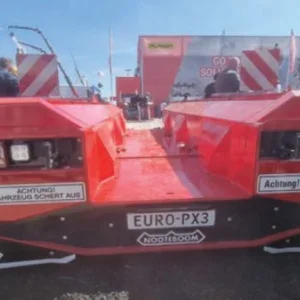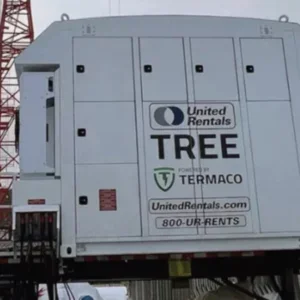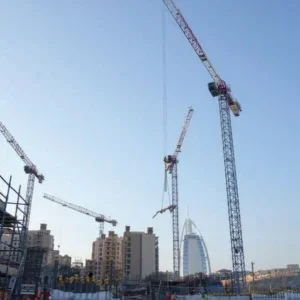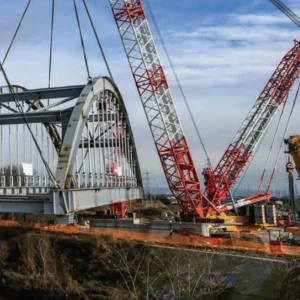A year can be a very long time in the crane industry. On the opening day of SAIE 2008, Fassi’smanaging director Giovanni Fassi joked that his company was “not ready to cry just yet”, while acknowledging the prospect of a marked drop in orders this year and next. “We expect sales to be down by 35% in 2009,”he said.
In fact, the reality turned out to be worse than that. Fassi’s spokesman, Silvio Chiapusso, reveals that sales for the year to date are down by about 50%. “But the climb back has begun, and some specific markets are reacting more than others: we’re seeing an increase in sales in the Italian, French and Spanish markets. Now we’re in the same position we were in before the summer slowdown period, around April,” he says.
Dario Mantovani, export manager for Benazzato, also reports a drop in sales of 50% over the past year. ”They have been very low this year, to be frank,” he says. “But they are just starting to improve; we are beginning to receive enquiries again from all over the world, although they completely stopped for several months. Now we’re getting enquiries that give us more hope.”
Serena Vultaggio of Raimondi’s sales department says, “our sales are suffering like those of everyone in our field”, while Nicola Corti at FB Gru admits that, “as for other manufacturers and in other countries, our sales and the market generally are very slow here in Italy.”
Massimo Casotto, sales manager for Locatelli, says that after experiencing “two euphoric years”, the company’s sales have returned to a more normal level. “Each individual deal is subject to real negotiation,”he explains. “There is direct engagement between the customer and our sales agents, who provide detailed information about technical aspects, supply availability and so on. Locatelli pursues a company policy of ‘just in time’: all that is produced is sold with a minimum stock of finished products ready to deliver.”
Does this mean that Locatelli has had to cut back on its production capacity? Casotto says not: “Overall, we haven’t reduced our output from what we were producing over the last few years. In mid-2008 we actually increased production to take account of a structural change. This balances out present market conditions so that, as of August 2009, our output was 10% less than last year, but we were still maintaining good levels of production of our cranes. Given the present state of the market worldwide, we consider that to be a very good outcome. We’re very happy with the level of production we’re maintaining.”
Fassi has reduced its production capacity, admits Chiapusso. “We have cut production as a consequence of the reduction in our sales,”he says. “We went into short-time working earlier this year, with our plant operating on a one-weekon, one-week-off basis. Then, as with all industry in Italy, we closed for the whole of the month of August.”
Being able to close the factory for half the month was made possible by a programme of Italian government financial assistance called cassa integrazione, effectively a temporary layoff state funding which pays firms in Italy the wages for its employees in the weeks when they are not working. Nick Sturland of the Italian Trade Commission in London describes it as being “very similar to our unemployment benefit system in Britain.
“It applies to individuals, not to companies, and workers are insured for up to 70% of what they are earning at the time the funding comes into force. It is usually used by one company for up to a year, though in some circumstances it can be used for up to two years.”
The Italian government’s spending on cassa integrazione is capped at EUR8bn in any one year. “We used this government assistance from the beginning of this year until August,” says Chiapusso. “Currently, as of September, we’re not sure what will happen in the future.”
It’s a similar story at FB Gru, who says that production has been reduced due to the poor level of enquiries it has received, and at Benazzato. “Our production has been less than 50% of what it was last year,” says Mantovani. “It’s general, across the board: all types of cranes are affected. Sales of very large cranes are still up, but that’s not our market. We are more affected by the slump than are companies that deal in big cranes. But the size of our company allows us to be more flexible than large ones can. We have had to lay off some staff, but we have been using cassa integrazione to pay our workers. It is saving us time, saving us money and saving the company. All Italian companies are using cassa integrazione: it’s very important help from the government.”
Looking ahead, Casotto says that Locatelli is ready to face the market when the recovery comes because it is investing in research and development, and is designing new models to meet new market demands. “During this quieter period, we are also focusing on keeping staff motivated on working on design and production. Another important objective is the constant improvement of the service network and spare parts, to provide customers with complete and efficient aftersales service,” he says. “We’re concentrating on ensuring we are able to provide customers with a continuous range, including new models to augment what is already in production. So we are developing an in-depth control of our suppliers’network while constantly working to enhance and evolve technical details and test new construction technologies to make all our cranes increasingly functional.”
Part of the company’s re-appraisal of its supply network was realised on 1 September, when it signed a collaboration agreement with the company Melino Macchine Industriali, based in Simeri Crichi, Calabria. Melino Macchine Industriali will sell Locatelli cranes and provide aftersales service and spare parts for Locatelli products in central and southern Italy, except Sardinia, operating directly with its own sales staff.
For Benazzato, too, the present slowdown is being used to strengthen relationships. “At the moment, we are working on keeping our sub-contractors happy,” says Mantovani. “If you don’t take care of your sub-contractors and give them work, they’ll do something else, go elsewhere. We’re trying to keep them close to us by keeping them informed of our situation and operation. This probably works better with a smaller company such as ours than with bigger companies. The relationships we have with our suppliers for all components are closer than those that large companies can have.”
Raimondi is taking the same approach, according to Vultaggio. “While sales are slow, we are taking the opportunity to improve some of our internal procedures and particularly our customer care service to both old and brand new customers, giving them our best level of assistance,” she explained. “We are always ready to give any advice required, from suggestions about the right model of crane they may need for their job site to analysing specific needs, or immediate aftersales help, solving any kind of problem in relation to the customer and/or job site in the shortest time. We are also reinforcing our commercial relationships so that, when recovery comes, we are ready to face the usual dynamic market we are used to, which hopefully will come sooner rather than later.”
Fassi is taking two main steps in readiness for improved market conditions, says Chiapusso: retaining staff and maintaining development. “At the next SAIE in Bologna, we will be introducing some new products and services, focusing on the introduction of the new FX500 moment limiter. The FX500 system, which is designed for installation on light and medium duty cranes, provides automatic management of the safety devices on the cranes and interacts with both performance control and functional/operational management to make these functions easier to use. We’re also promoting the XP system, which allows increased power; the latest RCS/RCH remote control systems; and we’re setting up a test field on our stand, where an instructor will be on hand to help operators who want to test the safe driving mode of a Fassi crane. Our commitment to safety has already led to the establishment of a new service for all crane operators in Italy and, with training centres throughout the country, Fassi now provides a training path worked out with ISPESL, leading to a certificate for driving cranes in conditions of absolute safety.”
Undoubtedly, the downturn in the world market has given many companies the time to take stock of their strategies and methods, focus on research and development and to analyse and study projects, including updating existing products.
According to Casotto, Locatelli “continues to invest in the workforce to improve the quality of products, fixtures and finishes. Our technical department is investing in the study and design of new products – for example, a new RT crane that will become the top-range model, with a maximum capacity of over 60t – and introducing new structural changes. We are updating other models so that all our cranes have the same quality standards already adopted in some new models of RT cranes.
Raimondi’s Vultaggio says, “We are constantly dedicated to new studies, designs and projects so that we are ready to face any demand from the present and future market. One of our specialities is that our technical department is able to analyse in a short time particular and unusual job sites and give practical solutions.”
FB Gru reported that it is using the downtime to focus on improving its range of cranes with new products to appeal to a larger number of potential customers. “The requests we get are mainly for high top slewing cranes,” said Corti.
Benazzato is not developing any new products at the moment, although it is working on some new technology and modifications of existing products, says Mantovani. “We’re taking advantage of the current low level of work to do things we don’t normally have time to do.
“It’s the same everywhere: we’re all just waiting for things to start happening again. There is light at the end of the tunnel, but the problem is that we don’t know the length of the tunnel.”






